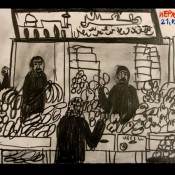What are the specifics of the Jerusalem project? You traveled in many cities with plein-air projects.
No specifics… It is just a different place. As simple as that. Feropontovo, Solovky islands, Norilsk, Krasnoyarsk, Norway – each is a different reality, and so is Jerusalem. Different weather, different people, houses.
However, there is a certain connection, for me, with the orientalists of the 19th century, which did not exist in other places. In Norilsk, for instance, the only artists painting the place before us, were Soviet painters, following a request from the central Art Fund. Jerusalem, Sinai, Morocco are all well explored, artistically, by many good folks such as Delacroix, and on the other hand, by more salon kind of artists such as Fortuny, Chernetzov (to take a Russian for an example). Jerusalem is certainly different from Morocco, which we know from Matisse and other French painters, or Tunis, as we see it in early Klee. However, Thus, there is an oriental theme – camels, Bedouins, Arabs – exotic things, that have an ironic connection, for me, to the artistic tradition I mentioned earlier. Narghile smokers, seller of buns, oriental crowd by the Damascus Gate – I indulge with great pleasure in rolling those words on my tongue. Or the tomb of the Holy Mother – one recalls lithographs or water colors of the 18th – 19th century: “A view of Jerusalem from the Silwan Valley”. You feel a strong urge to paint such a landscape, with two Bedouins and a camel. It turns out however, that it is covered by quite ugly buildings now, so it is all kind of weird…
But of course, all these magic words do influence, and the magic realities of the Church of Holy Sepulchre, the Western Wall, the Dome of the Rock – all this is certainly not something one would encounter in any city…
Otherwise – “Chukcha sings what he sees”, you know, be it Feropontovo or Jerusalem.
From a conversation with Alexander Florensky. April 2012, Jerusalem
ВЕРНУТЬСЯ НА СТРАНИЦУ “ИЕРУСАЛИМСКИЙ ПЛЕНЭР”
 Русский
Русский  English
English  עברית
עברית 





































































































